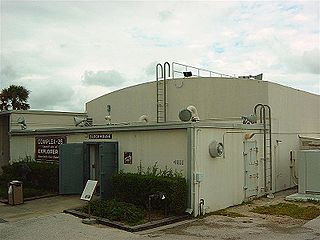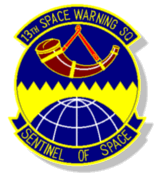Related Research Articles
The SM-65 Atlas was the first operational intercontinental ballistic missile (ICBM) developed by the United States and the first member of the Atlas rocket family. It was built for the U.S. Air Force by the Convair Division of General Dynamics at an assembly plant located in Kearny Mesa, San Diego. Atlas became operational in October 1959, but was soon made obsolete as an ICBM by new development, and was retired from this role by 1965.

Vandenberg Air Force Base is a United States Space Force Base located 14.8 km (9.2 mi) northwest of Lompoc, California. Established in 1941, Vandenberg Air Force Base is a space launch base, launching spacecraft from the Western Range and also performs missile testing. The United States Space Force's 30th Space Wing serves as the host wing for the base. In addition to its military space launch mission, Vandenberg Air Force Base also performs space launches for civil and commercial space entities, such as NASA.

Cape Canaveral Space Force Station (CCSFS) is an installation of the United States Space Force's 45th Space Wing, located on Cape Canaveral in Brevard County, Florida.

The United States Space Force's 10th Space Warning Squadron, is a missile warning unit located at Cavalier AFS, North Dakota.

Space Launch Complex 17 (SLC-17), previously designated Launch Complex 17 (LC-17), was a launch site at Cape Canaveral Space Force Station, Florida used for Thor and Delta rocket launches between 1958 and 2011.

Launch Complex 19 (LC-19) is a deactivated launch site on Cape Canaveral Space Force Station, Florida used by NASA to launch all of the Gemini manned spaceflights. It was also used by unmanned Titan I and Titan II missiles.

Launch Complex 26 (LC-26) is a deactivated launch site at Cape Canaveral Space Force Station, Florida. LC-26 consisted of two pads, A and B. Pad A was used for the Jupiter-C and Juno I rockets, and was the launch site for Explorer 1, the United States' first satellite, in 1958. Pad B was used for Juno II. Jupiter IRBMs were launched from both pads.

The 30th Space Wing is a United States Space Force space launch wing. The 30th Space Wing is assigned to Space Operations Command and headquartered at Vandenberg Air Force Base, California. The 30th Space Wing is responsible for all space launch operations from the west coast, which includes all polar launches. It manages the Western Range and launch activities for the Space Force, Department of Defense, NASA, and other private space corporations. The 30th Space Wing also supports test and evaluation launches of the U.S. Air Force's intercontinental ballistic missile force.

The 45th Space Wing is a United States Space Force space launch wing. The 45th Space Wing is assigned to Space Operations Command and headquartered at Patrick Space Force Base, Florida. The wing also controls Cape Canaveral Space Force Station. The 45th Space Wing is responsible for all space launch operations from the East Coast. It manages the Eastern Range, including launch activities for the Space Force, Department of Defense, NASA, and other private space corporations.

The 13th Space Warning Squadron (13SWS) is a missile warning unit assigned to the United States Space Force and located at Clear Air Force Station 5 miles (8 km) south of Anderson, Alaska

The Air Force Space and Missile Museum is located at Launch Complex 26 at Cape Canaveral Space Force Station, Florida. It includes artifacts from the early American space program and includes an outdoor area displaying rockets, missiles, and space-related equipment chronicling the space and missile history of the US Space Force and other military branches.

Space Launch Complex 10, or Missile Launch Complex 10, is located on Vandenberg Air Force Base in Lompoc, California. It was built in 1958 to test ballistic missiles and developed into a space launching facility in 1963. Prior to 1966 Space Launch Complex 10 West was known as Vandenberg AFB Pad 75-2-6. It remains a rare pristine look at the electronics and facilities created in that era that helped the United States grow its space capabilities.

Space Launch Complex 2 (SLC-2) is an inactive rocket launch site pending upgrades at Vandenberg Air Force Base, in California, USA. It consists of two launch pads. The East pad (SLC-2E) was used for Delta, Thor-Agena and Thorad launches between 1966 and 1972 and has been demolished. The West pad (SLC-2W) was used for Delta, Thor-Agena and Delta II launches from 1966 until 2018, when the Delta II performed its last flight.

Launch Complex 16 (LC-16) at Cape Canaveral Space Force Station, Florida is a launch complex built for use by LGM-25 Titan missiles, and later used for NASA operations before being transferred back to the US military and used for tests of MGM-31 Pershing missiles. Six Titan I missiles were launched from the complex between December 1959 and May 1960. These were followed by seven Titan II missiles, starting with the type's maiden flight on March 16, 1962. The last Titan II launch from LC-16 was conducted on May 29, 1963.

Launch Complex 31 (LC-31) is a former launch complex at Cape Canaveral Space Force Station, Florida.

The 30th Operations Group is a group of the United States Space Force. It is assigned to the 30th Space Wing, stationed at Vandenberg Air Force Base, California. It is responsible for all space launch operations from the West Coast of the United States, including all polar launches. It operates the Western Range, which conducts launches for the Space Force, other parts of the Department of Defense, NASA, and private space corporations.
Vandenberg Air Force Base Launch Facility 10 (LC-10) is a US Air Force Intercontinental ballistic missile launch facility on Vandenberg AFB, California, USA. It is a launch site for the land-based LGM-30 Minuteman ICBMs.
Launch Complex 32 (LC-32) is a former launch complex at Cape Canaveral Space Force Station, Florida.
Launch Complex 25 (LC-25) was a four-pad launch site at Cape Canaveral Space Force Station, Florida built for test flights of the US Navy's submarine-launched ballistic missiles Polaris, Poseidon and Trident from 1958–1979.

Launch Complex 45 (LC-45) is a former launch complex on Cape Canaveral Space Force Station created to launch the Roland missile. However, it was never used prior to its destruction, and Launch Complex 46 is now in its location.
References
- ↑ "Launch Complex 30". Air Force Space and Missile Museum. Retrieved 14 March 2016.
| | This space- or spaceflight-related article is a stub. You can help Wikipedia by expanding it. |